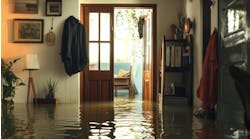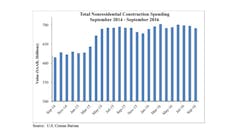Latest from Management
Show Customers All the Ways They Can Buy
Sponsored
Nonresidential construction spending down in September, but August data upwardly revised, says ABC
WASHINGTON, D.C. — Nonresidential construction spending fell 0.9 percent from August to September 2016, according to analysis of U.S. Census Bureau data released today by Associated Builders and Contractors (ABC). Nonresidential spending totaled $690.5 billion on a seasonally adjusted, annualized basis for the month, 0.7 percent below September 2015’s figure.
The government revised the August nonresidential construction spending estimate from $686.6 billion to $696.6 billion; otherwise September spending would have risen on a month-over-month basis. Eleven of 16 nonresidential construction subsectors experienced monthly declines.
“Since late 2015, the level of nonresidential construction spending in America has been effectively flat,” said ABC Chief Economist Anirban Basu. “Undoubtedly, soft U.S. economic growth has had an impact on nonresidential construction spending growth. For several quarters prior to the third quarter of 2016, U.S. economic growth hovered around 1 percent.
“However, public policy has also played a large part in shaping trends in nonresidential construction,” said Basu. “A number of primarily publicly financed construction segments have experienced declines in spending over the past year, including sewage and waste disposal (-18.8%), water supply (-13.7%), public safety (-13.0%) and transportation (-11.3%). Meanwhile, the level of construction spending in office, lodging and commercial segments is up on a year-over-year basis, though spending in the office and commercial categories was down on a month-over-month basis and lodging-related construction was roughly flat.
“It is conceivable that uncertainty regarding federal, state and local elections is negatively impacting state and local government infrastructure spending,” said Basu. “That uncertainty causes projects to be shelved. However, it is also possible that governments are shifting resources away from capital spending and toward other priorities, including surging Medicaid expenditures, rising compensation costs and underfunded pensions.
“Private spending growth in a number of categories softened a bit in September, perhaps because commercial real estate lenders have become increasingly concerned about potential overbuilding in certain segments and geographies,” warned Basu. “The implication is that nonresidential construction spending growth may not accelerate anytime soon, though there is some hope that the period following the elections will usher forth a period of renewed spending growth."



